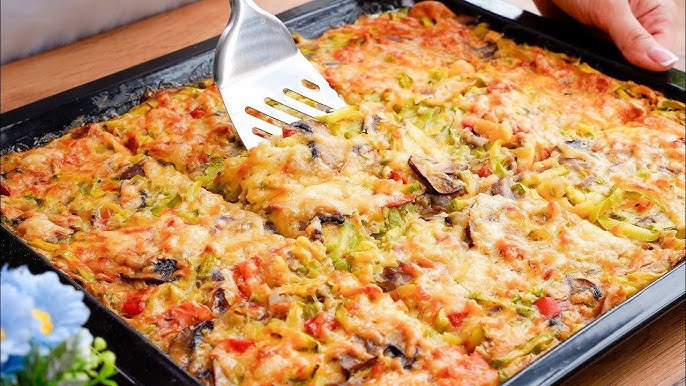Casserole Recipe: If comfort food had a mascot, it would definitely be the humble casserole. A casserole is a one-dish meal typically baked in the oven, where all ingredients cook together to create a harmonious, hearty, and flavorful dish. The beauty of casseroles lies in their versatility. They often include a combination of meat, vegetables, a starchy component like pasta or rice, and a binder such as cheese, cream, or broth.
This dish has roots in both European and American culinary traditions and has become a staple on dinner tables around the world. Whether you’re throwing together a quick midweek meal or preparing a dish for a family gathering, a casserole fits the bill. Plus, there’s something undeniably satisfying about scooping a hot, bubbling portion onto your plate.
Why Casseroles are a Family Favorite
Casseroles are loved for more than just their taste. They save time, reduce cleanup, and allow for endless creativity. Have some leftover rotisserie chicken? Toss it into a casserole. Veggies about to go bad? Chop ’em up and bake them in. It’s the ultimate fridge-cleaning dish that somehow always turns out great.
They’re also great for batch cooking. Make one, eat it today, and store portions for the rest of the week. That’s why casseroles have become a go-to for busy families and meal preppers alike.
Essential Ingredients for a Classic Casserole
Let’s break down what goes into making a mouthwatering casserole.
Proteins: Chicken, Beef, or Vegetarian
Your choice of protein sets the tone for the entire casserole. Here are a few popular options:
- Chicken: Versatile and mild, it pairs well with creamy sauces and hearty veggies.
- Ground Beef: Perfect for Tex-Mex or Italian-style casseroles with tomato sauces and spices.
- Tuna or Salmon: Great for seafood lovers—classic tuna noodle casserole, anyone?
- Tofu or Beans: For vegetarians or anyone looking to cut down on meat.
Each option brings its own texture and flavor, so think about what mood you’re going for.
Vegetables: Fresh or Frozen?
Vegetables bring color, crunch, and nutrients to your dish. You can go fresh, frozen, or even canned in a pinch. Here are some all-stars:
- Carrots, Celery, Onions: The classic trifecta that works with nearly any flavor profile.
- Broccoli or Cauliflower: Ideal for creamy, cheesy casseroles.
- Spinach, Zucchini, or Peas: For lighter, greener options.
Frozen veggies are a fantastic time-saver and often retain their nutrients better than fresh when properly frozen.
Grains and Carbs: Pasta, Rice, or Potatoes
This is your base, the element that gives your casserole its “stick-to-your-ribs” quality:
- Pasta: Macaroni, penne, or egg noodles are top choices.
- Rice: Brown, white, or even wild rice can change the texture and taste.
- Potatoes: Use thinly sliced potatoes for scalloped casseroles or mashed potatoes for a shepherd’s pie-style top layer.
Pick what you already have or what complements your protein and veggies best.
Sauces and Binders: Creamy, Tomato-Based, or Broth?
No casserole is complete without a binding sauce to pull everything together. Here are the heavy hitters:
- Cream-Based Sauces: Think cream of mushroom or homemade béchamel.
- Tomato-Based: Ideal for Italian or Mediterranean flavors.
- Broths and Stocks: Lighter and perfect for rice or potato-based casseroles.
Don’t forget the cheese! Mozzarella, cheddar, and parmesan are all frequent guests in casserole recipes.
Kitchen Tools You’ll Need
Must-Have Utensils for Prepping
Before diving in, gather your tools. You don’t need a gourmet kitchen—just a few essentials will do:
- Cutting board and a sharp knife for chopping ingredients.
- Frying pan or skillet to brown meat or sauté veggies.
- Mixing bowls for combining ingredients evenly.
- Measuring cups and spoons for precision.
Having everything within arm’s reach will make your prep smoother and faster.
The Right Baking Dish
Not all dishes are created equal, and the right one makes a big difference in your final product. Most casseroles are baked in:
- 9×13 inch Glass or Ceramic Dishes: These are standard and distribute heat evenly.
- Cast Iron Skillet: Great for going from stove to oven, plus it retains heat like a champ.
- Disposable Foil Trays: Perfect for meal prep or make-ahead freezer meals.
Just make sure whatever dish you use is oven-safe and deep enough to handle those hearty layers.
Step-by-Step Guide to Making the Perfect Casserole
Now for the main event—let’s build your casserole from scratch.
Step 1: Preheat and Prep
Start by preheating your oven to around 350°F (175°C). While it’s warming up, prep your ingredients:
- Chop your vegetables.
- Boil pasta or rice if needed (unless using instant or pre-cooked).
- Shred your cheese and measure out seasonings.
Mise en place—everything in its place—makes a huge difference.
Step 2: Cook Your Proteins
Sauté or brown your proteins first. For example:
- Cook chicken breast and cube it.
- Brown ground beef and drain the excess fat.
- For vegetarian options, lightly season and sauté tofu or beans to infuse flavor.
This step ensures your casserole bakes evenly and nothing ends up undercooked.
Step 3: Sauté the Veggies
Toss your veggies in a bit of oil or butter and sauté until just tender. Don’t overdo it—they’ll cook more in the oven.
If you’re using frozen vegetables, there’s no need to cook them beforehand unless the recipe calls for it.
Step 4: Mix in Grains and Sauce
Now bring it all together. In a large bowl, combine:
- Cooked proteins
- Sautéed veggies
- Cooked grains
- Sauce or broth
- Half your cheese
Mix until every bite is coated. Taste and adjust seasoning if needed.
Step 5: Assemble and Bake
Layer the mixture into your baking dish. Sprinkle the remaining cheese on top. For extra crunch, top with:
- Bread crumbs
- Crushed crackers
- French fried onions
Cover with foil and bake for about 25-30 minutes. Remove foil and bake an additional 10-15 minutes until bubbly and golden.
Pro Tips for a Flavorful Casserole
Seasoning Hacks
You’d be surprised how much of a difference a few seasoning tricks can make. Bland casseroles are usually the result of under-seasoning or not seasoning in layers. Don’t just toss in salt and pepper at the end—season every component as you go. When cooking your protein or sautéing veggies, throw in some garlic powder, onion powder, paprika, thyme, or even a dash of chili flakes for heat.
One secret weapon? A splash of soy sauce or Worcestershire sauce—just a little boosts umami and adds depth without overpowering your dish. And don’t forget the importance of acid. A tiny squeeze of lemon or a spoonful of vinegar can brighten heavy, creamy casseroles.
Layering Techniques
When assembling your casserole, think about texture and taste. If you’re using a grain like rice or pasta, put it on the bottom so it absorbs all the delicious juices. Next, layer your proteins and vegetables, followed by the sauce and cheese.
This structured layering helps each ingredient cook evenly. Want a crunchy topping that doesn’t burn? Add it halfway through the bake time or cover with foil and remove it at the end.
How to Avoid Soggy Bottoms
Nobody likes a watery casserole. Here are a few tips to prevent that sad, soggy outcome:
- Drain canned veggies and cooked pasta thoroughly.
- If using fresh tomatoes or zucchini, lightly salt them first to draw out excess water.
- Don’t overdo the liquid in your sauce—start with less, and you can always add more if needed.
- Pre-bake ingredients like potatoes before layering to remove moisture and create structure.
Variations and Customizations
Vegetarian Casserole Options
Going meatless? No problem. A veggie casserole can be just as hearty and delicious as its meat-based cousin. Here’s how:
- Use hearty vegetables like mushrooms, zucchini, and sweet potatoes.
- Add legumes like lentils or black beans for protein.
- Opt for a creamy béchamel or cheesy sauce made with plant-based milk and vegan cheese.
Try combinations like spinach and ricotta, mushroom and quinoa, or a Tex-Mex style black bean and corn casserole. The flavor possibilities are endless.
Spicy Southwest-Inspired Casserole
Craving something bold? Spice things up with a Southwest flair:
- Use ground beef or turkey as your base.
- Add black beans, corn, jalapeños, and red peppers.
- Mix with salsa and shredded cheddar cheese.
- Top with crushed tortilla chips for a crunchy finish.
This variation brings heat, texture, and that irresistible cheesy pull in every bite.
Kid-Friendly Cheesy Chicken Casserole
For picky eaters, simplicity is key. A cheesy chicken casserole is always a hit:
- Use shredded rotisserie chicken.
- Mix with cooked pasta, broccoli florets, and a cheesy cream sauce.
- Top with breadcrumbs and bake until golden.
You can even sneak in finely chopped veggies—they’ll be too busy loving the cheesy goodness to notice.
Storing and Reheating Leftovers
Best Practices for Freezing
Casseroles are ideal for freezing, making them the ultimate meal prep hero. If you’re planning to freeze a casserole, follow these tips:
- Use a foil or freezer-safe container.
- Let the casserole cool completely before freezing.
- Wrap tightly in plastic wrap and foil to prevent freezer burn.
- Label with the date and reheating instructions.
For the best texture, undercook your casserole slightly before freezing. When reheated, it finishes cooking perfectly.
How to Reheat Without Drying Out
Dry leftovers? Not on our watch. To reheat a casserole and keep it moist:
- Cover with foil and bake at 350°F until heated through (usually 25–30 minutes).
- Add a splash of broth or milk before baking if it looks dry.
- For quicker reheating, microwave single portions with a damp paper towel on top to keep moisture in.
Casseroles also taste even better the next day, once the flavors have had time to meld—so don’t be afraid of leftovers!
Common Mistakes to Avoid
Overcooking Ingredients
One of the biggest casserole crimes? Overcooked, mushy ingredients. It’s important to remember that most casseroles bake for 30–45 minutes. So if your pasta, veggies, or meat are already fully cooked before they go into the oven, they can turn to mush by the time you’re done.
Pro tip: Cook your ingredients just shy of done—they’ll finish cooking in the oven and retain a better texture.
Using the Wrong Dish Size
Using a dish that’s too small causes spillover. Too big? You’ll end up with a thin, dried-out casserole. A standard 9×13 inch dish is perfect for most recipes.
To be safe:
- Stick to what the recipe recommends.
- If improvising, make sure the mixture isn’t more than 2 inches deep in the pan.
Forgetting the Crunchy Topping
That golden, crispy topping? It’s more than just garnish—it adds texture and makes your casserole look as good as it tastes. Whether you use breadcrumbs, shredded cheese, crushed crackers, or fried onions, don’t skip this part!
Want to keep it from burning? Add it toward the end of baking, and if it’s browning too fast, lightly tent with foil.
Healthier Alternatives and Substitutions
Low-Carb Options
Watching your carbs? You don’t have to give up casseroles. Swap out traditional bases with:
- Cauliflower rice instead of regular rice.
- Zucchini noodles instead of pasta.
- Mashed cauliflower instead of potatoes.
Combine with lean proteins like chicken or turkey and lots of colorful veggies for a guilt-free, flavor-packed dish.
Dairy-Free and Gluten-Free Choices
Dairy or gluten intolerance doesn’t mean you’re missing out.
- Use almond or oat milk for creaminess.
- Nutritional yeast or dairy-free cheese for that cheesy kick.
- Gluten-free pasta or rice works great as a substitute.
Look for thickening agents like cornstarch or arrowroot if avoiding flour-based sauces. With so many allergy-friendly products available, creating an inclusive casserole is easier than ever.
What to Serve with Your Casserole
Simple Side Salads
Casseroles are filling on their own, but a fresh, crisp salad on the side balances things out beautifully. Try these combos:
- Caesar Salad: Crunchy romaine with creamy dressing and croutons works great with rich, cheesy casseroles.
- Garden Salad: A mix of lettuce, cherry tomatoes, cucumbers, and a light vinaigrette provides a refreshing contrast.
- Spinach and Strawberry Salad: Sweet and savory elements make this a great side for chicken or veggie casseroles.
Don’t overthink it—just keep the salad light and crunchy to offset the warmth and creaminess of your main dish.
Bread, Rolls, and Garlic Toast
Nothing complements a casserole like something warm and carb-y on the side to help scoop up every last bite. Here are some winners:
- Buttery Dinner Rolls: Soft and pillowy, perfect for creamy or meat-heavy casseroles.
- Garlic Bread: Especially great with Italian-style casseroles.
- Cornbread: Sweet and savory, and a must-have for chili or southwestern casseroles.
These additions complete your comfort food dream plate and are super easy to prep while the casserole bakes.
FAQs about Casserole Recipe
1. What is a casserole?
A casserole is a one-dish meal baked in the oven, typically made with a combination of protein (like chicken or beef), vegetables, a starchy binder (like pasta, rice, or potatoes), and a creamy or cheesy sauce.
2. Can I make a casserole ahead of time?
Absolutely! Most casseroles can be assembled a day in advance and refrigerated. Just cover it tightly and pop it in the oven when you’re ready to bake.
3. How long do you cook a casserole?
It depends on the recipe, but most casseroles bake at 350°F (175°C) for 30 to 45 minutes—until hot and bubbly.
4. Can I freeze casseroles?
Yes! Casseroles freeze beautifully. Assemble it (but don’t bake), wrap it well, and freeze for up to 3 months. Thaw overnight in the fridge before baking.
5. What’s the best dish to use for casseroles?
A 9×13-inch glass or ceramic baking dish is the gold standard. It cooks evenly and makes cleanup easy.
6. How do I keep a casserole from drying out?
Cover it with foil during baking or add a little extra sauce or broth. You can also top it with cheese or breadcrumbs to help lock in moisture.
7. Can I make a vegetarian casserole?
For sure! Swap out the meat for hearty veggies like mushrooms, zucchini, beans, or lentils for a satisfying meat-free option.
8. Are casseroles healthy?
They can be! Use lean proteins, lots of vegetables, whole grains, and light sauces to make your casserole both delicious and nutritious.
Conclusion
Casseroles are one of those rare dishes that check every box—comforting, easy to make, versatile, and perfect for any day of the week. Whether you’re feeding a crowd or just meal prepping for the week, a good casserole is your best kitchen friend.
They let you get creative, clean out your fridge, and still end up with something downright delicious. And with all the tips, tricks, and customization ideas in this guide, you’re more than ready to master the art of the casserole. So go ahead—pick your protein, toss in those veggies, layer it up with sauce and cheese, and get baking. Your belly (and your family) will thank you.



